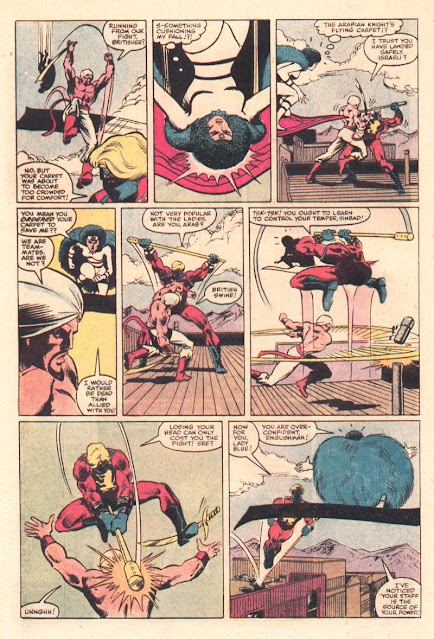From the comic itself, I knew that writers Mark Gruenwald, Steven Grant and Bill Mantlo conceived the CONTEST storyline (with Mantlo alone credited with the dialogue). I did not know before reading the Science Fiction.com essay that the same threesome had authored a 1980 Marvel Treasury Edition which had Spider-Man fight the Hulk with the Winter Olympics as a background. For CONTEST this team brought together all, or nearly all, extant Marvel heroes for a contest that also would have been Olympic-themed had the U.S. not withdrawn from 1980's Summer Olympics. This was at least one reason that the completed John Romita Jr. art for this planned Treasury Edition was shelved for a couple of years, until Marvel finally published it as a limited series in regular comics format-- albeit after many corrections to the art were made to bring it in line with 1982 continuity.
The most interesting thing about CONTEST from a contemporary POV is that John Romita Jr's art looks nothing like what readers expect of his work today. At this point in his career, Romita Jr.'s art didn't even look that much like that of his famous father. If only because of the need of stuffing dozens of heroes into one narrative, here he looks a lot like George Perez, particularly in this two-page crowd scene:
(Note: in the real Marvel Universe, Sub-Mariner would probably squash Ant-Man if the latter stood on his shoulder. And maybe the Werewolf, off to the far left, is relatively calm because his human half in control, though the script never says so.)
The art on average is just adequate, though it's still better than the Mike Zeck pencils on SECRET WARS-- though it's been rumored that Zeck was obliged to follow thumbnails from his scripter-and-boss Jim Shooter. I can see Shooter advocating such a project because he was aware that Marvel's strength was its shared-universe of long-underwear characters, and he may well have modeled SECRET WARS on this mini-series-- with one important difference.
In SECRET WARS, every character abducted to "Battleworld" has something to do, no matter how banal the actions might be. Here, nearly all the 1982 heroes are abducted to partake in a game played between two cosmic beings-- but of those dozens of heroes, only twenty-four are active participants. The two game-players, the Grandmaster and a mysterious entity revealed to be the Marvel incarnation of Death, decide that they will play four games with Earth superheroes with their pawns, pitting three of Grandmaster's choices against three of Death's in a treasure-hunting schtick. All of the other characters apparently just chill out in some bunker until the four games are done, and eventually everyone's allowed to go home.
The motive for the game is that the Grandmaster wants Death to revive his brother The Collector. Mantlo et al try to give this boring idea a twist at the end, but clearly the only real attraction of the story is the crossover aspect. And because Mantlo et al were modeling this selective conflict on the real-world Olympics, they created a bunch of newbie non-American heroes-- Australian, French, etc.-- who get heavily featured in the match-ups. I interpret this as the authors' awareness that the New X-Men's success was partly attributable to its multi-national makeup. However, to the best of my knowledge none of the newbies went on to great fame, at best showing up as guest-stars here and there-- so the writers didn't quite manage to tap into Marvel's new mythos of Superheroes, International Style.
Though the story is routine and the characters deliver long expository lectures at the drop of a hat, Mantlo does keep the characterizations relatively consistent and even pens a few funny bits here and there. And for my purposes, CONTEST provides an apt illustration of my theory about the difference between superordinate and subordinate ensembles. In other mega-crossovers that I've analyzed, I have to show how particular "starring" characters stand out from "supporting" characters. But in CONTEST, it's clear that only twenty-four characters comprise the serial's superordinate ensemble, while everyone else, no matter how winsomely Romita Jr draws them, is relegated to the subordinate bunker.




No comments:
Post a Comment